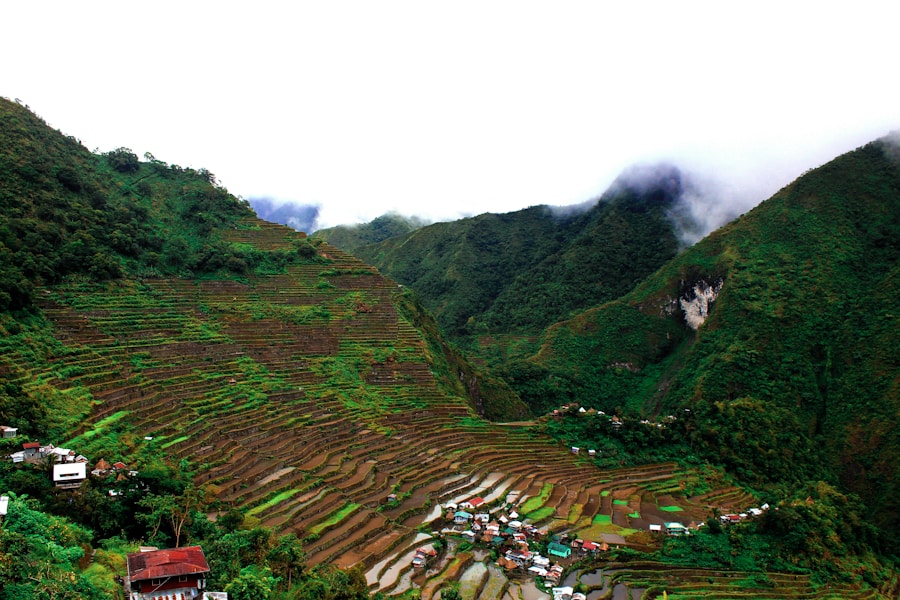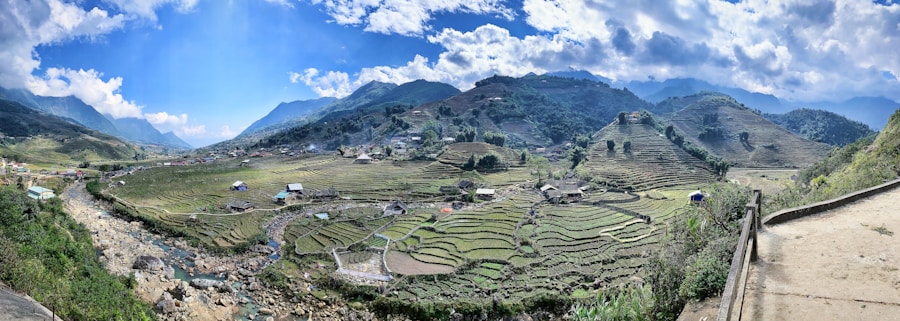Download links
How to install Banaue Rice Terraces: A Wonder of Agricultural Engineering APK?
1. Tap the downloaded Banaue Rice Terraces: A Wonder of Agricultural Engineering APK file.
2. Touch install.
3. Follow the steps on the screen.
Description
The Banaue Rice Terraces, often referred to as the “Eighth Wonder of the World,” boast a rich history that dates back over 2,000 years. These terraces were carved into the mountains of Ifugao province in the Philippines by the indigenous Ifugao people, who developed sophisticated agricultural techniques to cultivate rice in a challenging mountainous environment. The construction of these terraces is believed to have begun around 2000 B.C., although some estimates suggest that the actual origins may be even older.
The terraces are not merely agricultural fields; they represent a deep connection between the Ifugao people and their land, showcasing their ingenuity and resilience in adapting to their environment. The historical significance of the Banaue Rice Terraces extends beyond their agricultural function. They are a testament to the Ifugao’s cultural heritage, reflecting their social structure, beliefs, and practices.
The terraces were built using traditional methods passed down through generations, emphasizing communal labor and cooperation among families and clans. This collective effort not only fostered a sense of community but also reinforced the Ifugao’s spiritual connection to their land. The rice terraces are interwoven with local myths and legends, further embedding them in the cultural fabric of the Ifugao people.
As such, they serve as a living monument to a way of life that has persisted for millennia, despite external pressures and modernization.
Key Takeaways
- The Banaue Rice Terraces were built over 2,000 years ago by the Ifugao people without the use of modern technology, making them a marvel of ancient engineering.
- The terraces are not only a feat of engineering, but also hold great cultural significance for the Ifugao people, who consider them a symbol of their identity and heritage.
- The terraces have had a significant environmental impact, as they have helped to preserve the region’s biodiversity and have contributed to the conservation of water resources.
- Despite their historical and cultural importance, the Banaue Rice Terraces face challenges such as soil erosion, lack of maintenance, and the migration of younger generations to urban areas.
- The future of the Banaue Rice Terraces depends on efforts to preserve and maintain them, as well as on promoting sustainable tourism and ensuring the involvement of the local community in their conservation.
The Engineering Behind the Banaue Rice Terraces
Water Management and Irrigation
The terraces are built on steep slopes, with each level meticulously designed to capture and retain water, essential for rice cultivation. The Ifugao people utilized a system of irrigation that channels water from nearby rivers and streams into the terraces, ensuring that each level receives adequate moisture.
The construction of the terraces involved significant labor and skill. The Ifugao used simple tools made from bamboo and stone to carve out the terraces, creating a series of flat fields that ascend the mountainsides.
Enduring Construction
Each terrace is supported by stone walls, which were built without mortar, relying instead on precise stone placement to create stability. This technique has allowed many of the terraces to withstand the test of time, enduring natural disasters such as earthquakes and typhoons. The engineering principles employed in the Banaue Rice Terraces reflect a deep understanding of local geology and climate, demonstrating how traditional knowledge can lead to sustainable agricultural practices.
The Cultural Significance of the Banaue Rice Terraces

The cultural significance of the Banaue Rice Terraces extends far beyond their agricultural utility; they are a symbol of identity for the Ifugao people. The terraces are deeply embedded in their cultural practices, rituals, and social structures. For instance, rice is not merely a staple food; it holds profound spiritual meaning in Ifugao culture.
It is often used in rituals and ceremonies, signifying prosperity and abundance. The planting and harvesting seasons are marked by various traditional celebrations that reinforce community bonds and cultural identity. Moreover, the terraces serve as a canvas for expressing Ifugao artistry and craftsmanship.
The intricate designs of the stone walls and the layout of the terraces reflect a unique aesthetic sensibility that is characteristic of Ifugao culture. Traditional practices such as weaving and wood carving often draw inspiration from the natural beauty surrounding the rice terraces. This artistic expression is not only a means of preserving cultural heritage but also plays a crucial role in educating younger generations about their history and traditions. The terraces thus stand as a living testament to the Ifugao people’s resilience, creativity, and deep-rooted connection to their land.
The Environmental Impact of the Banaue Rice Terraces
| Aspect | Metric |
|---|---|
| Deforestation | Approximately 85% of the original forest cover has been lost due to terrace construction and agricultural activities. |
| Biodiversity | The terraces support a rich diversity of plant and animal species, including endemic and endangered species. |
| Soil Erosion | The construction of the terraces has led to significant soil erosion, impacting the fertility of the land. |
| Water Management | The terraces have a complex irrigation system that requires constant maintenance to ensure efficient water distribution. |
| Climate Change | The terraces play a role in mitigating climate change by sequestering carbon and reducing soil erosion. |
The environmental impact of the Banaue Rice Terraces is multifaceted, encompassing both positive and negative aspects. On one hand, the terraces have contributed significantly to biodiversity conservation in the region. By creating micro-ecosystems within each terrace, they provide habitats for various plant and animal species.
The traditional farming practices employed by the Ifugao promote organic agriculture, which helps maintain soil health and reduces reliance on chemical fertilizers and pesticides. This sustainable approach has allowed for a rich diversity of crops beyond rice, including vegetables and herbs that thrive in this unique environment. However, the environmental sustainability of the Banaue Rice Terraces is increasingly threatened by climate change and human activities.
Changes in weather patterns have led to unpredictable rainfall, affecting irrigation systems that have functioned effectively for centuries. Additionally, deforestation and land conversion for other agricultural purposes have resulted in soil erosion and loss of biodiversity in surrounding areas. The delicate balance that has been maintained for generations is now at risk, prompting concerns about the long-term viability of these ancient agricultural systems.
Addressing these environmental challenges requires a concerted effort to integrate traditional knowledge with modern conservation practices.
The Challenges Facing the Banaue Rice Terraces
Despite their historical significance and cultural value, the Banaue Rice Terraces face numerous challenges that threaten their preservation. One of the most pressing issues is the decline in traditional farming practices among younger generations. As urbanization increases and economic opportunities shift towards non-agricultural sectors, many young Ifugao are leaving their ancestral lands in search of better livelihoods in cities.
This migration has led to a decrease in labor available for maintaining the terraces, resulting in neglect and deterioration of these once-thriving agricultural landscapes. Additionally, external pressures such as tourism can pose significant challenges to the sustainability of the rice terraces. While tourism brings economic benefits to local communities, it can also lead to environmental degradation if not managed responsibly.
Increased foot traffic can cause soil erosion, while infrastructure development for tourism can disrupt local ecosystems. Balancing economic development with environmental conservation is crucial for ensuring that the rice terraces remain viable for future generations. Engaging local communities in sustainable tourism initiatives can help mitigate these impacts while providing them with alternative sources of income.
The Future of the Banaue Rice Terraces

Promoting Cultural Heritage and Community Pride
Recognizing their cultural and historical significance, various organizations have initiated programs aimed at revitalizing traditional farming practices among younger generations. Educational initiatives that emphasize the importance of these terraces not only as agricultural sites but also as cultural heritage can inspire pride and encourage youth participation in their preservation.
Integrating Modern Technology with Traditional Practices
Integrating modern technology with traditional practices offers promising avenues for enhancing sustainability. For instance, utilizing drone technology for monitoring terrace conditions or implementing water conservation techniques can improve agricultural productivity while minimizing environmental impact.
Towards a Sustainable Future
Collaborative efforts between local communities, government agencies, and non-governmental organizations are essential for developing comprehensive strategies that address both economic needs and environmental sustainability. In conclusion, while challenges abound for the Banaue Rice Terraces, there is hope for their future through concerted efforts aimed at preservation and sustainable development. By fostering a sense of community ownership and pride in this unique cultural landscape, it is possible to ensure that these ancient agricultural marvels continue to thrive for generations to come.
The Banaue Rice Terraces in the Philippines are a stunning example of ancient agricultural engineering. For a different perspective on sustainable practices in Southeast Asia, check out the article “Perspektif Pangingisda di Indonesia”. This article explores the fishing industry in Indonesia and how it relates to environmental conservation efforts in the region. For more insightful articles on a variety of topics, visit Outlook Science. If you’re interested in discovering the most highly rated apps for staying informed and connected, be sure to explore this list of top-rated apps.
FAQs
What are the Banaue Rice Terraces?
The Banaue Rice Terraces are ancient terraces carved into the mountains of Ifugao in the Philippines. They are often referred to as the “Eighth Wonder of the World” and are a UNESCO World Heritage Site.
How were the Banaue Rice Terraces created?
The terraces were hand-carved over 2,000 years ago by the Ifugao people using minimal equipment, primarily using their bare hands and simple tools. The terraces were created to make the mountainous terrain suitable for rice cultivation.
How large are the Banaue Rice Terraces?
The Banaue Rice Terraces cover approximately 10,360 square kilometers of mountainside. They are often referred to as the “stairway to the sky” due to their impressive scale and design.
What is the significance of the Banaue Rice Terraces?
The terraces are not only a stunning example of ancient engineering and agricultural practices, but they also hold cultural and historical significance for the Ifugao people. They are a symbol of their heritage and connection to the land.
Can visitors explore the Banaue Rice Terraces?
Yes, visitors are welcome to explore the Banaue Rice Terraces. There are hiking trails and viewpoints that offer breathtaking vistas of the terraces and the surrounding landscape. It is important to respect the local customs and environment while visiting.





